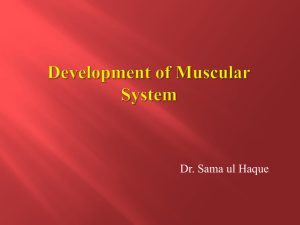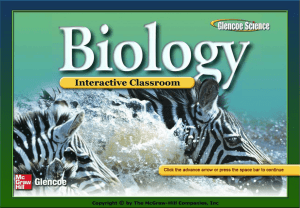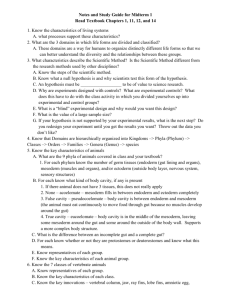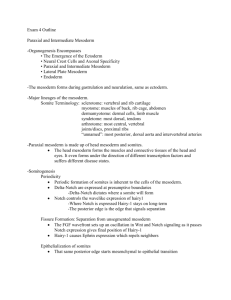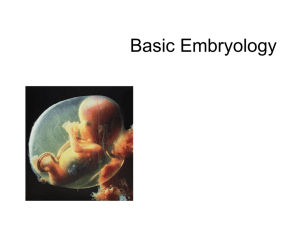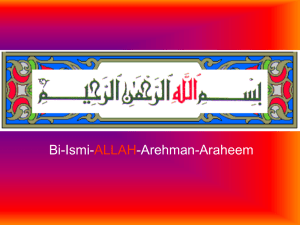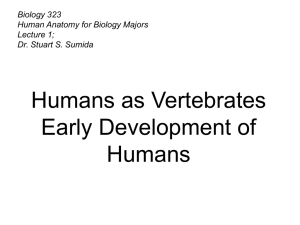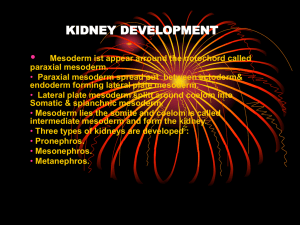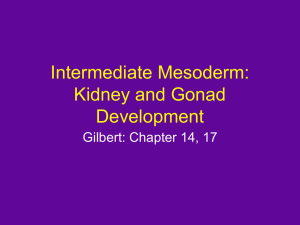There are four major lineages of the mesoderm
advertisement
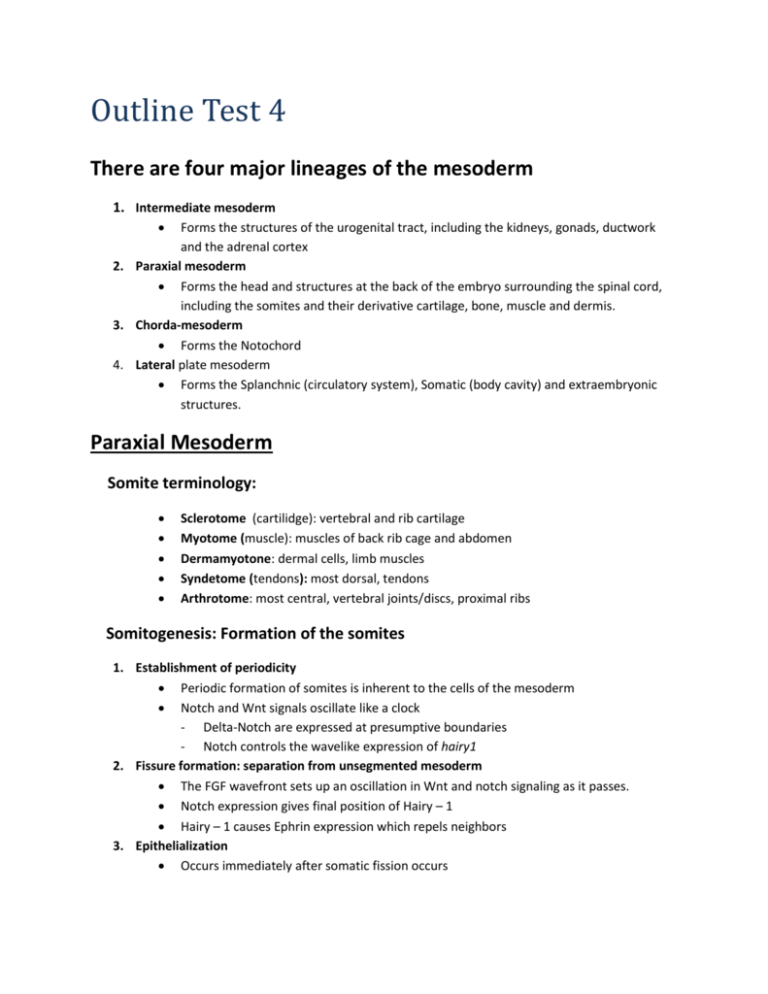
Outline Test 4 There are four major lineages of the mesoderm 1. Intermediate mesoderm Forms the structures of the urogenital tract, including the kidneys, gonads, ductwork and the adrenal cortex 2. Paraxial mesoderm Forms the head and structures at the back of the embryo surrounding the spinal cord, including the somites and their derivative cartilage, bone, muscle and dermis. 3. Chorda-mesoderm Forms the Notochord 4. Lateral plate mesoderm Forms the Splanchnic (circulatory system), Somatic (body cavity) and extraembryonic structures. Paraxial Mesoderm Somite terminology: Sclerotome (cartilidge): vertebral and rib cartilage Myotome (muscle): muscles of back rib cage and abdomen Dermamyotone: dermal cells, limb muscles Syndetome (tendons): most dorsal, tendons Arthrotome: most central, vertebral joints/discs, proximal ribs Somitogenesis: Formation of the somites 1. Establishment of periodicity Periodic formation of somites is inherent to the cells of the mesoderm Notch and Wnt signals oscillate like a clock - Delta-Notch are expressed at presumptive boundaries - Notch controls the wavelike expression of hairy1 2. Fissure formation: separation from unsegmented mesoderm The FGF wavefront sets up an oscillation in Wnt and notch signaling as it passes. Notch expression gives final position of Hairy – 1 Hairy – 1 causes Ephrin expression which repels neighbors 3. Epithelialization Occurs immediately after somatic fission occurs Ectodermal signals appear to cause the peripheral somatic cells to undergo mesenchymal to epithelial transition by lowering the Cdc42 levels in these cells. 4. Specification The somites are specified according to the hox genes they express. 5. Differentiation All of the cells of the somite are competent to form all the derivative cell types (cartilage, bone, muscle, tendons, dermis, vascular cells, meninges) Fate depends on their position near the neural tube, notochord, epidermis and intermediate mesoderm. Mechanisms of Tissue formation from Somites 1. Myogenesis: muscle formation Come from 2 cell lineages in somite, the paraxial and the abaxial. Cells in the center give rise to satellite cells Paracrine factors instruct cells to become muscles by inducing them to synthesize the Myf-5 and Myo-D proteins Adult muscle cells (myotubule) are large and multinucleated 2. Osteogenesis: Bone formation Four Different sources of bone: - Somites from axial skeleton - Lateral plate mesoderm from limb skeleton - Cranial neural crest forms face and head bones - Mesodermal mesenchyme in patella, periosteum Two different processes - Endochondrial ossification in the first two - Intramembrane ossification in the second two 3. Vascular replacement in the Dorsal Aorta Blood vessels are a single layer of endothelium surrounded by multiple layers of smooth muscle. Dorsal aorta forms a primary model by vasculogenesis and then both the endothelium and smooth muscle replaced by somite. 4. The Syndetome: Tendon Formation Tendon joins bone to muscle Last row of sclerotome is induced by overlying myotome to differentiate into those connectors Intermediate Mesoderm Formation of kidney from Intermediate Mesoderm The adult kidney is complex - Single nephron has 10,000 cells which hae 12 cell types - Each is positioned exactly for its job relative to others Embryo increasingly need to filter blood - Intermediate mesoderm forms organizer - The pronerphric duct then induces three stages of kidney - The first two stages are transitory, the third persists. General scheme of development in the vertebrate kidney - Nephric duct is the primitive organizer: Wolfmann Duct - Pronephros is functional in fish, amphibians, not in mammals then degenerates - Mesonephros is functional in some mammals, including human, and degenerates in females, forms epididymous and was deferens. Metanephros formed by reciporical induction with Wolffian Duct - Intermediate mesoderm mesenchyme develops into kidney while the wolffian duct matures into collecting duct. Lateral Plate Mesoderm Terminology: Somatoplure: somatic mesoderm plus ectoderm Splanchnopleure: splanchnic mesoderm plus endoderm Ceolom: body cavity forms between them Coelom Eventually the left and right cavities fuse into one and runs from the neck to the anus in vertebrates Portioned off by folds of somatic mesoderm - Pleural cavity: surrounds the thorax and lungs - Pericardial cavity: surrounds the heart - Peritoneal cavity: surrounds the abdominal organs. Heart Development Anatomical stages - Tube formation 1. Cardiogenic mesoderm migrates out of the mesodermal layer towards the endoderm to form endocardial tubes on either side 2. At same time endoderm is folding inward 3. Endoderm continues to form inward until it forms its own tube, which drags the two endocardial primordial closer to each other 4. Endocardial are surrounded by myocardial progenitors and when endocardial tubes get close enough, they fuse together. - Looping o o o o o - Left and right asymmetry due to Nodal and Pitx 2 Looping requires: 1. Cytoskeletal arrangement 2. Extracellular matrix and remodeling 3. Asymmetric cell devision Heart valves keep blood from flowing back to chamber which it was ejected. Septa separates the 2 atria and 2 ventricles The truncus arteriosis, or outflow tract, also becomes septated Chamber formation o Formation of the chambers and valves of the heart: 1. Endocardial cushions form and fuse 2. Septa grow towards cushion 3. Valves form from myocardium Blood Vessel Development Blood vessels form independently from the heart They form for embryonic needs as much as adult The vessels are constrained by evolution The vessels adapt to the law of fluid dynamics The development of blood vessels occurs in two temporarally separate processes: 1. Vasculogenesis - Involves the formation of blood islands and the construction of capillary networks from them 2. Angiogenesis - The growth and remodeling of the 1st vessels in response to blood flow and tissue – derived recruitment signals. Lymphiatic drainage forms from jugular vein - Sprouts as lymphatic sacs by angiogenesis - Continues to form secondary drainage system - Major conduit for immune cells Development of the Endoderm The digestive tube Anterior endoderm forms anterior intestinal portal Posterior endoderm forms posterior intestinal portal Midgut goes through expansion and contraction of yolk Each end has ectodermal cap, then forms entrance The derivatives of the Digestive tube: 4 pharyngeal pouches from head and neck structures - The cranial neural crest cells migrate through the endoderm and contribute component structures around them. Floor between 4th pair buds out from respiratory tube - Localized Wnt/B-catenin and retonic acid cause budding Gut tube forms esophagus, stomach , SI, LI, Rectum - Anterior – posterior specification of the gastrointestinal tract due to regional transcription factors - Reciporical induction: silutaneous anterior-posterior specification of both endoderm and mesoderm Gut tube buds out to form liver, gall bladder, pancreas - Mesoderm also induces liver bud - Pancreas develops from the fusion of distinct dorsal and ventral diverticula. The Extraembryonic Membranes: Adaptation for development on dry land - As the body starts to develop epithelium expands to isolate embryo within them Four sets of extraembryonic membranes - Somatoplure forms amnion and chorion o Amnion folds up to cover the embryo and keep it from drying out o Chorion surrounds the entire embryo and controls gas exchange - Splanchnopleure forms yolk sac and allantois o Yolk sac expands to surround yolk o Allantoic membrane creaes a space for waste exchange Development of the Tetrapod Limb Pattern formation - Similarities o Arcitectual symmetry in all four limbs o Size symmetry in the opposite limb o Symmetry in growth rate and development - Differences o Forelimb-Hindlimb: Rostral-caudal asymmetry o Mirror imagery in opposite limbs; left-right symmetry o Structural polarity in 3 axes per limb Skeletal pattern formation - The pattern extends to muscles, tendons, cartilage, vessels and nerves Molecular Specification of the Pattern - Morphogenic rules cross species - Axis formation is driven by specific molecules o Proximal-Distal axis governed by FGF family o Anterior-Posterior axis governed by Shh o Dorsal-Ventral axis governed by Wnt7a Emergence of the limb bud - Bulge is due to proliferation and migration of somatic mesoderm for bone abaxial myotome for muscle. Proximal-Distal patterning - As mesoderm mesenchyme forms the limb bud it tells overlaying ectoderm to form the Apical Ectodermal Ridge (AER) - The AER then directs changing limb development in nearby mesoderm called Progress Zone Anterior-posterior patterning - The “Zone of Polarizing activity” is a piece of mesoderm at the junction of the young limb bud and the body wall - When a ZPA is grafted to anterior limb bud mesoderm, duplicated digits emerge as a mirror image of the normal digits. - The concentration of Shh dictates the anterior and posterior in the developing limb and is critical - The Shh pattern is made more intricate by response in the webbing Dorsal-ventral Patterning - Knuckes vs palm axis is determined by the overlaying ectoderm - Inhibition of cell death is caused by inhibition of BMPs
